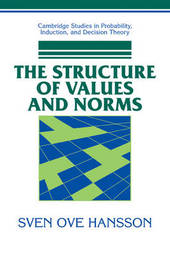
|
The Structure of Values and Norms
Paperback / softback
Main Details
| Title |
The Structure of Values and Norms
|
| Authors and Contributors |
By (author) Sven Ove Hansson
|
| Series | Cambridge Studies in Probability, Induction and Decision Theory |
|---|
| Physical Properties |
| Format:Paperback / softback | | Pages:332 | | Dimensions(mm): Height 229,Width 154 |
|
| Category/Genre | Philosophy - logic |
|---|
| ISBN/Barcode |
9780521037235
|
| Classifications | Dewey:121.8 |
|---|
| Audience | | Professional & Vocational | |
|---|
| Illustrations |
4 Tables, unspecified; 2 Line drawings, unspecified
|
|
Publishing Details |
| Publisher |
Cambridge University Press
|
| Imprint |
Cambridge University Press
|
| Publication Date |
19 May 2007 |
| Publication Country |
United Kingdom
|
Description
Formal representations of values and norms are employed in several academic disciplines and specialties, such as economics, jurisprudence, decision theory and social choice theory. Sven Ove Hansson closely examines such foundational issues as the values of wholes and the values of their parts, the connections between values and norms, how values can be decision-guiding and the structure of normative codes with formal precision. Models of change in both preferences and norms are offered, as well as a method to base the logic of norms on that of preferences. Hansson has developed a unified formal representation of values and norms that reflects both their static and their dynamic properties. This formalized treatment, carried out in terms of both informal value theory and precise logical detail, will contribute to the clarification of certain issues in the basic philosophical theory of values and norms.
Reviews'Hansson has written an excellent book on the logic of preferences and norms ... the book is by no means written for logicians only ... Anyone interested in economics, decision theory, political philosophy or social choice theory is well advised to familiarize herself with the (not too difficult) logical machinery, as there are lots of insights to be reaped from Hansson's work.' Journal of Economics & Philosophy
|